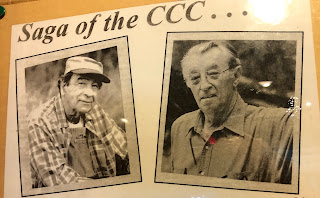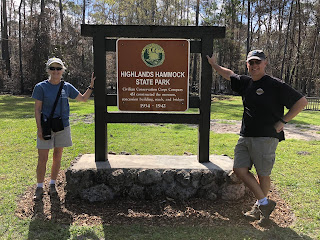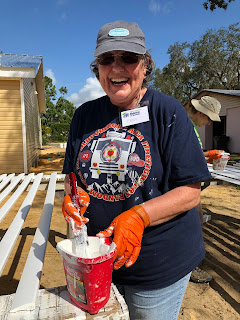In our quest to visit as many Florida's state parks as possible, Tim and I, along with our friends Doug and Chris, spent a Saturday in Highlands Hammock State Park.
Created in part by a sizable donation from Margaret Shippen Roebling, the park opened in 1931 four years before the Florida state park system was founded. Just as an aside, Margaret was the wife of John Augustus Roebling II whose grandfather John Augustus Roebling and father Washington Augustus Roebling built the Brooklyn Bridge, the iconic bridge that links New York City to Brooklyn.
In the park, we found another bridge not quite so tall but with an interesting history told by the park's small museum devoted to the Civilian Conservation Corps. The CCC, as it was known, took over the park's works in 1933, constructing bridges as well as dams to control the water levels.
Exhibits told the story of the hundreds of young men who answered President Franklin Delano Roosevelt's call to work for the good of the country. "Through you the nation will graduate a fine group of strong young men...willing and proud to work for the joy of working."
 |
| Walter Matthau (left) and Robert Mitchum (right) |
Interestingly enough, among the men who joined the Corp in their youth later became famous celebrities Walter Matthau, Robert Mitchum and Raymond Burr.
 |
| Alvin C. York (left upper corner) and Raymond Burr (right) |
The World War I hero, Alvin C. York whose feat of singlehandedly capturing 132 German prisoners vividly portrayed by Gary Cooper in the movie Sargent York, served as a CCC superintendant in Crossville, Tennessee.
But nature beckoned so we quit the museum and headed to the park's hiking trails for an up close and personal view of the hammock, a term unfamiliar to me in this context.
A hammock is defined as a forest whose large trees filter out much of the sunlight, making the inside of the forest dark, shady and cool.
We investigated the bark of the slash pine trees
and sat on knobby trunk of a bald cypress tree.
Reaching high I tried to compare my height with the span of the roots of a toppled tree.
Then I bent low to view these tiny purple blossoms nestled among the abundant ferns.
We stayed a respectful distance away from this alligator who was basking in the sun. He brought to mind this anonymous poem as he made me want to run.
Alligators Are Unfriendly
Alligators are unfriendly,
they are easily upset.
I suspect that I would never
care to have one for a pet.
Oh, I know they do not bellow,
and I think they do not shed,
but I'd probably be nervous
if I had one in my bed.
Alligators are not clever,
they are something of a bore.
they can't heel or catch a Frisbee,
they don't greet you at the door,
for their courtesy is lacking,
and their tempers are not sweet,
they won't even fetch your slippers
...though they just might eat your feet.
See you later, alligator!








































